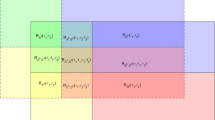Abstract
For various quasi-synchronous (QS) CDMA systems, to reduce or eliminate the multiple access interference and multipath interference, it is required to design a set of spreading sequences which are mutually orthogonal within a designed shift zone. In this article, we demonstrate that a concept of irregular spatial assignment, with flexibility to assign different number of users to different cells, can be used to provide the maximal number of orthogonal sequences in any three adjacent cells in networks with a regular tessellation of hexagonal cells. We first consider p-phase spreading sequences of length \(p^m\) (thus nonbinary p-valued sequences) suitable for synchronous (S)-CDMA applications, for \(p>3\), and give an efficient design method for reaching the maximal cardinality achievable (being \(p^m\)). A simple solution for a flexible assignment of our orthogonal sets of spreading sequences to the cells in hexagonal networks is given. To address QS-CDMA applications as well, an efficient method to combine these orthogonal sequences with Zadeoff–Chu sequences is proposed for the purpose of designing sets of zero correlation zone (ZCZ) sequences (within a certain shift zone) with optimal parameters, thus reaching the Tang–Fan–Matsufuji bound. A similar design framework, based on the use of some special classes of Boolean functions, is then employed for the binary case to provide the maximum cardinality of pairwise orthogonal sequences of length \(2^m\) through this irregular spatial assignment. This improves upon the best known results achieved in Zhang et al. (IEEE Trans Inf Theory 62:3757–3767, 2016), which assigns \(2^{m-2}\) orthogonal sequences (users) per cell, by doubling the number of users in one third of the network.




Similar content being viewed by others
References
Chee S., Lee S., Kim K.: Semi-bent functions. In: Advances in Cryptology-ASIACRYPT’94, vol. 917, pp. 107–118. LNCS. Springer, Berlin (1994).
Dinan E., Jabbari B.: Spreading codes for direct sequence CDMA and wideband CDMA cellular networks. IEEE Commun. Mag. 36, 48–54 (1998).
Fan P.: Spreading sequence design and theoretical limits for quasisynchronous CDMA systems. EURASIP J. Wirel. Commun. Netw. 1, 19–31 (2004).
Fan P., Hao L.: Generalized orthogonal sequences and their applications in synchronous CDMA systems. IEICE Trans. Fundam. Electron. Commun. Comput. Sci. E83-A, 2054–2069 (2000).
Fan P., Suehiro N., Kuroyanagi N., Deng X.M.: Class of binary sequences with zero correlation zone. Electron. Lett. 35, 777–779 (1999).
Gu Z., Zhou Z., Mesnager S., Parampalli U.: A new family of polyphase sequences with low correlation. Cryptogr. Commun. 14, 135–144 (2022).
Hu S., Liu Z., Guan Y.L., Xiong W., Bi G., Li S.: Sequence design for cognitive CDMA communications under arbitrary spectrum hole constraint. IEEE J. Sel. Areas Commun. 32, 1974–1986 (2014).
Hunt F.H., Smith D.H.: The construction of orthogonal variable spreading factor codes from semi-bent functions. IEEE Trans. Wirel. Commun. 11, 2970–2975 (2012).
Li J., Fan J., Tang X.: A Generic construction of generalized chirp-Like sequence sets with optimal zero correlation property. IEEE Commun. Lett. 17, 549–552 (2013).
Matsufuji S., Suehiro N.: Complex Hadamard matrices related to bent sequences. IEEE Trans. Inf. Theory 42, 637 (1996).
Popovic B.M., Mauritz O.: Generalized chirp-like sequences with zero correlation zone. IEEE Trans. Inf. Theory 56, 2957–2960 (2010).
Popovic B.M., Suehiro N., Fan P.: Orthogonal sets of quadriphase sequences with good correlation properties. IEEE Trans. Inf. Theory 48, 956–959 (2002).
Smith D.H., Ward R.P., Perkins S.: Gold codes, Hadamard partitions and the security of CDMA systems. Des. Codes Cryptogr. 51, 231–243 (2009).
Smith D.H., Hunt F.H., Perkins S.: Exploiting spatial separations in CDMA systems with correlation constrained sets of Hadamard matrices. IEEE Trans. Inf. Theory 56, 5757–5761 (2010).
Tang X., Fan P., Matsufuji S.: Lower bounds on correlation of spreading sequence set with low or zero correlation zone. Electron. Lett. 30, 551–552 (2000).
Tang X., Mow W.H.: Design of spreading codes for quasi-synchronous CDMA with intercell interference. IEEE J. Sel. Areas Commun. 24, 84–93 (2006).
Tang X., Fan P., Lindner J.: Multiple binay ZCZ sequence sets with good cross-correlation property based on complementary sequence sets. IEEE Trans. Inf. Theory 56, 4038–4045 (2010).
Yang K., Kim Y.K., Kumar P.V.L.: Quasi-orthogonal sequences for code-division multiple-access systems. IEEE Trans. Inf. Theory 46, 982–993 (2000).
Zhang W.G., Xie C.L., Pasalic E.: Large sets of orthogonal sequences suitable for applications in CDMA systems. IEEE Trans. Inf. Theory 62, 3757–3767 (2016).
Zhang L., Sun Y.: The optimal assignment of orthogonal polyphase sequences in CDMA systems. IEEE Commun. Lett. 22, 109–112 (2018).
Zhou Z., Zhang D., Helleseth T., Wen J.: A construction of multiple optimal ZCZ sequence sets with good cross correlation. IEEE Trans. Inf. Theory 64, 1340–1346 (2018).
Acknowledgements
W.-G. Zhang is supported by the National Natural Science Foundation of China (No. 61972303). E. Pasalic is supported in part by the Slovenian Research Agency (research program P1-0404 and research projects J1-9108, J1-1694, N1-0159, J1-2451).
Author information
Authors and Affiliations
Corresponding author
Additional information
Communicated by K.-U. Schmidt.
Publisher's Note
Springer Nature remains neutral with regard to jurisdictional claims in published maps and institutional affiliations.
Rights and permissions
About this article
Cite this article
Zhang, W., Pasalic, E. & Zhang, L. Phase orthogonal sequence sets for (QS)CDMA communications. Des. Codes Cryptogr. 90, 1139–1156 (2022). https://doi.org/10.1007/s10623-022-01031-5
Received:
Revised:
Accepted:
Published:
Issue Date:
DOI: https://doi.org/10.1007/s10623-022-01031-5




